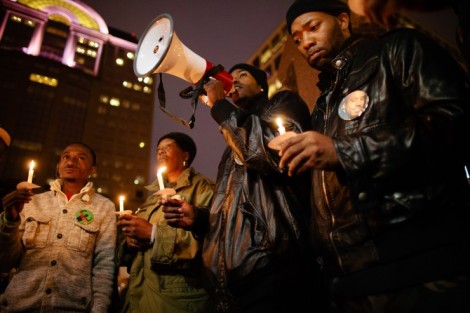
Directed by: Erik Ljung
Produced by: Erik Ljung
Executive Produced by: Barry Poltermann
Cinematography by: Erik Ljung, Daniel Thomas Peters
Edited by: Michael T. Vollmann
Official Selection of the 2017 SXSW Film Festival
*****
Angry, uncompromising, and politically unashamed, The Blood Is At The Doorstep represents the most forceful of a recent wave of nonfiction films dealing with police brutality and civilian murder in America.
It is also, as directed by Erik Ljung (who also shot the film with Daniel T. Peters), a strong first outing for the debut filmmaker, who appeared at the World Premiere screening at SXSW earlier this month. Through his work with VICE, Al Jazeera, and The New York Times, Ljung has developed a manner of integrating himself into tight communities – a skill on which his documentarian career pivots. Here, he comes close to being a big part of the story about Dontre Hamilton, “a black, unarmed man diagnosed with schizophrenia” who was shot (fourteen times) to death by a Milwaukee cop. The killing became national news, and Ljung traveled to Wisconsin in 2014 to follow the Hamilton family through grief, recovery, and protest.

The real subject of Ljung’s camera is not the media circus that comes to town, nor the traumatized family itself, which takes on the mantle of civil rights advocacy following Dontre’s murder. Editor Michael T. Vollmann and Ljung instead tell a classic story of karmic injustices, spiraling further away from the Hamiltons’ personal tragedy and closer to existential rumination on the nature of law in the United States.
While the multi-thread tale Vollmann tries to weave starts to fray in the second act, spinning off Dontre’s narrative in favor of a histrionic montage of national footage, the third act returns us commandingly to the modern day, where Nate Hamilton (Dontre’s brother) and his mother, Maria, continue the fight against law enforcement abuses. Sadly yet inevitably, the film concludes that the battle for justice is not only without end, but is also becoming less civil with each new, near-daily murder of a black citizen in our nation.
As the filmmakers push towards a wider-ranging set of stories, straying from the folk tragedy of Dontre Hamilton, a strange disjuncture forms: the film starts to argue for its own dialogism and importance rather than becoming more valuable for audiences. The profound essence of The Blood Is At The Doorstep is Dontre Hamilton, a beautifully tragic character sprung back to life through conversations between the family and the documentarian.

The specifics of his case are what identifies the case as a vital one for the historical record: he was shot by a police officer while laying in front of a Starbucks; he was a schizophrenic with unclear prospects; and one incredible photo shows that he was a ladies man with a perm in the nineties. Ljung, who at one point uses a stand-in for Dontre in a recreation sequence, crafts a rich human life without the man’s current physical form – if this is not empathic filmmaking, what is?
Nonetheless, to weave Dontre Hamilton’s story into the larger national narrative of police brutality and murder of African-Americans is an all-too-easy trope – because of its truthfulness, unfortunately – and it is one that deflates the power of Ljung’s inquisitive, friendly camera. To honor these individuals, their stories must be more idiosyncratic, and eccentrically told. Otherwise, when we end up forgetting the films, we run the risk of forgetting their stories.

